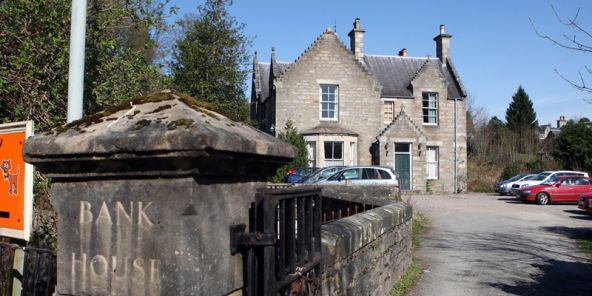Pitlochry people hoping to save a landmark in their town centre have suffered a mortal blow to their plans.
Protesters against the demolition of Bank House to make way for a budget hotel and supermarket had hoped that Historic Scotland would step in and overturn September’s council decision allowing the scheme to proceed.
But after months of consideration, the heritage watchdog has confirmed that it will not “call in” the application for Scottish ministers to determine.
James Tyrrell, the chairman of the Pitlochry Conservation Society (PCS), said: “It is truly a disaster day for Pitlochry, and for local democracy.”
Michael Scott, of Historic Scotland, said in a letter to Perth and Kinross Council planners: “Given the significance of Bank House as a building of merit in your council’s conservation area appraisal, we are disappointed that no positive attempt appears to have been made to retain and reuse this particular building.”
However, he goes on: “The site is a significant one, being located within the centre of Pitlochry. It is currently in poor condition and its regeneration is supported.
“We note the robust design process that has resulted in a good quality replacement scheme that appears to ministers to preserve or enhance the character and appearance of the conservation area.
“We note that your council has also given weight to the economic and social benefits of the proposed replacement scheme in reaching its conclusion that demolition is justified.
“We have no reason to doubt the merits of the replacement scheme, nor that economic benefits will result.
“On balance, whilst we believe that the considerations for demolition in Scottish Historic Environment Policy have not been fully met in respect of the retention of Bank House, as a property identified by your authority that contributes to the character of the conservation area, the loss of this unlisted building in the conservation area does not raise issues of such national significance that ministers would wish to intervene.
“We are thus clearing the case back to your authority to determine.”
The decision leaves the way clear for Upland Developments to tear down the derelict Victorian building and bring to an end a planning row which has dogged the town for more than three years.
Mr Tyrell said: “Not only is an irreplaceable building of merit being destroyed, but also a conservation area with great potential will disappear under a mass of unattractive concrete.
“The town showed the planners what could be done in a study which would have cost over £100,000 but for time donated by a professional team from The Mackintosh School of Architecture.
“Yet their impressive work, widely endorsed locally, was largely ignored, but for a few token gestures to better design.
“Now Pitlochry will have imposed upon it a cheap structure described by the Perth and Kinross planners themselves as ‘monolithic’. This, at the very centrepiece of one of Scotland’s more precious Victorian towns.
“The questions on everybody’s lips must be how could this be allowed to happen in a town with such tourist potential and unique reputation, and what will the tourists think of it?”
He continued: “To suggest that the Bank House could not have been saved is ludicrous. Much of its dilapidated appearance was due to the developer’s lack of interest in maintaining its gardens, as this helped his proposal.
“Immediately prior to the sale of that land, a notable local trust had shown an interest in purchasing it for their own use. Historic Scotland were made aware of this fact, as were Perth and Kinross councillors and planners.”
